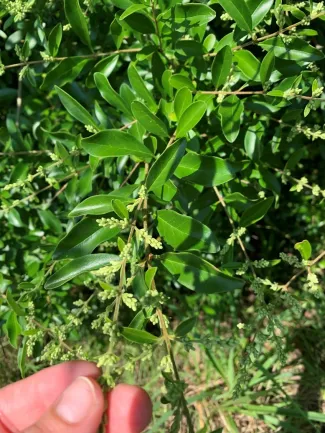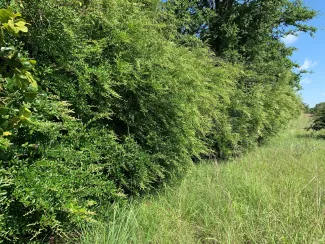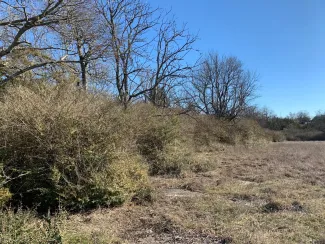The plant community is one of the biggest considerations when managing or improving wildlife habitat. The species of plants and how they grow either directly or indirectly affects the five habitat requirements of every wildlife species: food, water, cover, space, and arrangement. As such, it is essential for us to be familiar with the plants occurring on our property. Are they native to Oklahoma or introduced? Non-native, invasive plants create many problems particularly by degrading the quality of native plant community and structure, which negatively affects our wildlife populations.

Chinese privet is not native to Oklahoma and can spread quickly within a variety of habitat types.
The Plant: Chinese Privet
Chinese privet (Ligustrum sinense) is an introduced shrub originating in Asia and finding its way to the U.S. as an ornamental plant. In Oklahoma, Chinese privet can be found in several counties scattered across the eastern half of the state and becoming less prevalent moving west out of the pine woods and cross timbers regions.
It is a semi-evergreen with opposite, ovate leaves, growing as tall as 10 feet, and producing white flower clusters in spring that become fruit-like clusters in summer. As a semi-evergreen, it can be easily identified in the winter.
This shade-tolerant shrub inhabits uplands, bottomlands, and forests, and is particularly troublesome along forest or woodland edges where it can grow into a dense shrub wall, severely reducing or eliminating travel for humans and many wildlife.

“Walls” of Chinese privet can deter or prevent wildlife from using or traveling through wooded areas.
The Problem
Like most invasive plants, the issue is typically not the individual plant. In fact, in some cases wildlife will use these non-native invasives for one reason or another.
Five Chinese privet shrubs scattered across a 100-acre property would not raise much concern; however, as is the problem with all invasive plants, they tend to be extremely prolific where they take hold. Nearly all invasive species will effectively outcompete native plant species, creating monocultures of themselves and severely degrading plant diversity. In the case of Chinese privet, the issues created far outweigh any minor benefits. Since Chinese privet invades transitional edges and beneath trees, this is particularly detrimental for turkey habitat. Loafing areas within woodlands will become unusable, escape cover along edges can become hazardous, and roost trees will eventually be avoided as these shrubs take over.

The Solution
Whether you only have a few plants or a severe invasion situation, the best approach is to take action as soon as possible. Chinese privet can be controlled using a few different methods.
Cut Stump application
For low density infestations, where individual plants are scattered or where plants are too tall to allow for effective foliar application, cut stump applications are an effective method of treatment. Cut the stems off at ground level using loppers or a chainsaw. Immediately paint or spray the stumps with a 1:3 mixture of triclopyr ester (Remedy Ultra) and diesel; a 50:50 mixture of triclopyr amine (Garlon 3A) and water; or a 1:3 mixture of glyphosate and water. Be sure to apply the herbicide to every stump, focusing the herbicide on the outer cambium of each stump.
Foliar application
For high density infestations, foliar applications may be the best option considering the more labor-intensive nature of the cut stump method. For foliar applications, a highly concentrated glyphosate solution is required. Using a high-pressure sprayer, apply a mixture of 4 ounces of glyphosate to 1 gallon of water to the shrub leaves in late summer or fall. Coat the leaves thoroughly from all sides but avoid excessive runoff.
Prescribed Fire w/ Stump Torching
If you are hesitant to use herbicide applications, fire is a more eco-friendly option. Cut the stems off at ground level in fall or early winter. During January though March, conduct a prescribed fire on the area. Know that the fire alone is not enough to kill the plant, so it is necessary to follow up with torching. After the prescribed fire, using a propane torch, torch each stump for 30 seconds.
Be vigilant in identifying and treating any invasive species occurring on your property. By doing this, you are protecting Oklahoma’s native plant communities that are vital for quality wildlife habitat.
Learn more about controlling invasive woody plants in this Oklahoma Invasive Plant Council webinar.